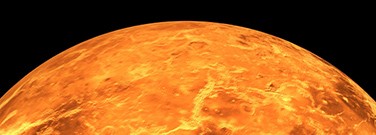Two New Venus Missions Set to Study the Planet’s Atmosphere and Topography

By Mike Howie
In early June of 2021, NASA administrator Bill Nelson announced that the agency will send two new robotic missions to Venus, the second planet from the Sun and one of Earth’s nearest neighbors. Costing up to a combined $1 billion, the missions will mark NASA’s first visits to the planet in nearly 30 years and are expected to launch by the end of this decade.
“We hope these missions will further our understanding of how Earth evolved and why it’s currently habitable when others in our solar system are not,” Nelson said. “This is really exciting stuff.”
DAVINCI+
The first of the two missions has been dubbed DAVINCI+, which stands for Deep Atmosphere Venus Investigation of Noble gases, Chemistry, and Imaging Plus. While the name may be a mouthful, the mission is fairly straightforward: NASA will pack an array of instruments into an armored sphere and send it through the Venusian atmosphere, where it will collect data that will help us learn more about the planet.
Noble gases present in the atmosphere could be particularly illuminating. They could help scientists understand whether Venus began life with as much water as Earth and whether the planet still has water deep in its interior that could fuel plate tectonics.
DAVINCI+ will also search for sulfur and carbon near the planet surface, which could be evidence of recent volcanic activity, and park an orbiter around Venus to map the planet’s geology. The mission will launch from NASA’s Goddard Space Flight Center in Greenbelt, Maryland, and be led by Jim Garvin, the Center’s chief scientist.
VERITAS
The second of the new missions is named VERITAS, which stands for Venus Emissivity, Radio science, InSAR, Topography, and Spectroscopy. Another mouthful, to be sure, but equally simple in concept: it will use synthetic aperture radar to recreate the topography of Venus in the hope of finding active volcanoes or variants of tectonic plates.
While measurements of Venus have been taken before, the planet’s thick clouds may have obscured some surface features. But with this high-resolution radar, scientists may find chasms that resemble Earth’s midocean ridges or get a better look at oval-shaped features called coronae.
Suzanne Smrekar, the planetary scientist who will lead the mission from NASA’s Jet Propulsion Laboratory in Pasadena, California, believes that Venus could be a good model to help us learn about the beginning of plate tectonics here on Earth. Because its greenhouse-heated surface is cooling much slower than Earth’s, it may just now be cracking into plates.
“We’re ushering in a new decade of Venus to understand how an Earth-like planet can become a hothouse,” said Thomas Zurbuchen, NASA’s science chief. “Our goals are profound. It is not just understanding the evolution of planets and habitability in our own solar system, but extending beyond these boundaries to exoplanets.”
Discussion Questions
- How can studying planets like Venus and Mars help us learn more about Earth?
- What other missions is NASA working on? How could they advance our understanding of the solar system?
Vocabulary
- Emissivity
- Exoplanet
- Noble Gas
- Spectroscopy